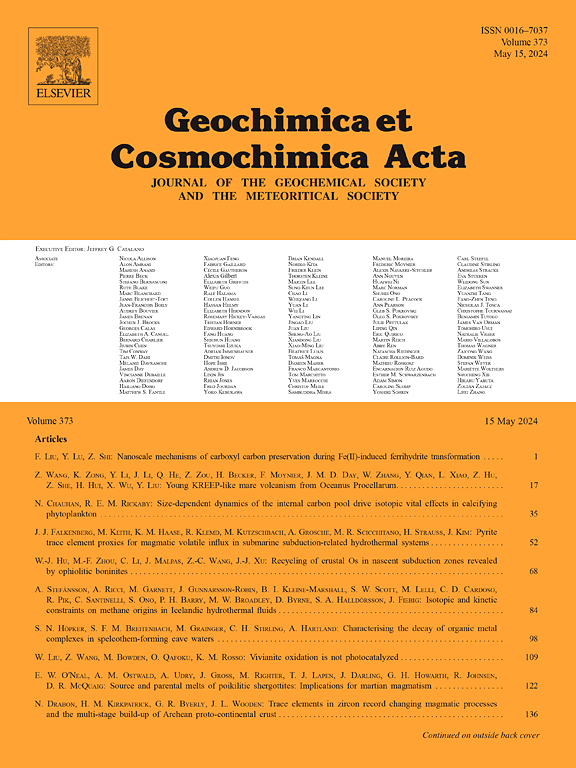含水玄武岩熔体中的氯和氯化钠
IF 4.5
1区 地球科学
Q1 GEOCHEMISTRY & GEOPHYSICS
引用次数: 0
摘要
我们使用Thomas和Wood(2021)的氯逸度控制方法确定了氯在高压(0.5-1.5 GPa)和温度(1200-1300°C)下在含水玄武岩熔体中的溶解度和行为。通过在固定氯氧逸度下系统地将熔体含水量从0 wt%增加到4 wt%,我们发现在所有研究条件下,H2O的加入都会导致氯浓度的增加。为了建立氯溶解度的综合方程,我们将我们的数据与Thomas和Wood(2021年,2023年)的60个无水成分的结果相结合。我们将每次实验的氯化物容量定义为:本文章由计算机程序翻译,如有差异,请以英文原文为准。
Chlorine and NaCl in hydrous basaltic melts
We have determined the solubility and behavior of chlorine in hydrous basaltic melts at high pressures (0.5–1.5 GPa) and temperatures (1200–1300 °C) using the chlorine fugacity control method of Thomas and Wood (2021). By systematically increasing the water content of the melt from 0 to 4 wt% at fixed chlorine and oxygen fugacities we find that addition of H2O leads to an increase in chlorine concentration under all conditions studied. In order to develop a comprehensive equation for chlorine solubility we combined our data with 60 results on anhydrous compositions from Thomas and Wood (2021,2023). We define chloride capacity CCl for each experiment as:
The 70 results were then fitted by stepwise linear regression to an equation containing pressure, temperature and compositional terms. Terms which did not pass the F-test (α = 0.05) were excluded. This approach led to the following fit-equation, with P in GPa and XSi XCa referring to mole fractions of the oxides on a single cation basis:
The standard error of the fit is 0.083 and R2 is 0.963. This equation closely approximates that obtained from the results on anhydrous compositions by Thomas and Wood (2023). Surprisingly the term in HO0.5 was found not to be significant, implying that water behaves as an ideal diluent with respect to chlorine.
We used our chloride capacity equation to calculate the activity of NaCl in experimentally-produced hydrous basalts of known chlorine content. The method involved combining chloride capacities with Na2SiO3 and SiO2 activities derived from the Rhyolite-MELTS program. The results for NaCl activity were found to be in reasonably good agreement with values obtained from the Thomas and Wood (2023) equation which had been based predominantly on data from silica-rich compositions. Finally, measurements of the compositions of melt inclusions from Etna were used to calculate the activities of NaCl in the inclusions and the salinities of fluids with which the inclusions would be in equilibrium. From the trapping pressures of the inclusions and their compositions we find that decompression from 500 MPa to ∼50 MPa is accompanied, in this case, by a salinity increase from <1 wt% NaCl to ∼50 % NaCl.
求助全文
通过发布文献求助,成功后即可免费获取论文全文。
去求助
来源期刊

Geochimica et Cosmochimica Acta
地学-地球化学与地球物理
CiteScore
9.60
自引率
14.00%
发文量
437
审稿时长
6 months
期刊介绍:
Geochimica et Cosmochimica Acta publishes research papers in a wide range of subjects in terrestrial geochemistry, meteoritics, and planetary geochemistry. The scope of the journal includes:
1). Physical chemistry of gases, aqueous solutions, glasses, and crystalline solids
2). Igneous and metamorphic petrology
3). Chemical processes in the atmosphere, hydrosphere, biosphere, and lithosphere of the Earth
4). Organic geochemistry
5). Isotope geochemistry
6). Meteoritics and meteorite impacts
7). Lunar science; and
8). Planetary geochemistry.
 求助内容:
求助内容: 应助结果提醒方式:
应助结果提醒方式:


